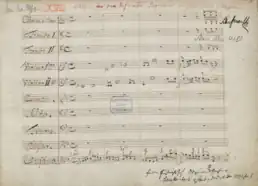Requiem (Michael Haydn)
Michael Haydn wrote the Missa pro defuncto Archiepiscopo Sigismondo, or more generally Missa pro Defunctis, Klafsky I:8, MH 155, following the death of the Count Archbishop Sigismund von Schrattenbach in Salzburg in December 1771. Haydn completed the Requiem before the year was over, signing it "S[oli] D[eo] H[onor] et G[loria.] Salisburgi 31 Dicembre 1771." At the beginning of that year, his daughter Aloisia Josefa[1] died. Historians believe "his own personal bereavement" motivated the composition.[2] Contemporary materials which have survived to the present day include the autograph score found in Berlin, a set of copied parts with many corrections in Haydn's hand in Salzburg and another set at the Esterházy castle in Eisenstadt, and a score prepared by the Salzburg copyist Nikolaus Lang found in Munich.[3]
| Requiem | |
|---|---|
| by Michael Haydn | |
 The composer | |
| Full title | Missa pro defuncto Archiepiscopo Sigismondo |
| Key | C minor |
| Catalogue | Klafsky I:8, MH 155 |
| Occasion | Requiem of Sigismund von Schrattenbach |
| Text | Requiem |
| Language | Latin |
| Composed | 1771 |
| Vocal | SATB choir and soloists |
| Instrumental |
|
Instrumentation

The mass is scored for the vocal soloists and mixed choir, two bassoons,[4] four trumpets in C, three trombones, timpani and strings with basso continuo.
Structure
The composition is structured in the following five parts:
- Requiem aeternam Adagio, C minor, common time
- Sequentia Dies irae Andante maestoso, C minor, 3/4
- Offertorium Domine Jesu Christe
- Sanctus Andante, C minor, 3/4
- "Benedictus qui venit..." Allegretto, E-flat major, 3/4
- Agnus Dei et Communio
- "Agnus Dei, qui tollis peccata mundi" Adagio con moto, C minor, common time
- "Cum sanctis tuis" Allegretto, C minor, cut time
- "Requiem aeternam" Adagio, C minor, common time
- "Cum sanctis tuis" Allegretto, C minor, cut time
Tempo
Sherman recommends a tempo relation in which "in Agnus Dei et Communio, the ![]() of both Agnus Dei and Requiem aeternam equals
of both Agnus Dei and Requiem aeternam equals ![]() of the fugue Cum sanctis tuis."[5] Sherman also recommends interpreting the Andante maestoso of the Dies Irae at "a pulse of
of the fugue Cum sanctis tuis."[5] Sherman also recommends interpreting the Andante maestoso of the Dies Irae at "a pulse of ![]() = MM. 104."[6] Leopold Mozart instructs "that the staccato indicates a lifting of the bow from the string" with no accent implied.[7]
= MM. 104."[6] Leopold Mozart instructs "that the staccato indicates a lifting of the bow from the string" with no accent implied.[7]
Influence in Mozart's Requiem
Both Leopold and his son Wolfgang Amadeus Mozart were present at the first three performances of Haydn's Requiem in January 1772,[8][9] and Wolfgang was influenced in the writing of his own Requiem in D minor, K. 626.[10] In fact, Michael Haydn's Requiem is "an important model for Mozart" and strongly suggests that Franz Xaver Süssmayr's completion of Mozart's way does not depart "in any way from Mozart's plans."[11] Pauly notes specific parallels between the two requiems: rhythmic similarities in the setting of the Introit, Quantus tremor and Confutatis maledictis sections, the use of a plainchant melody in the setting of Te decet hymnus, and the subject of the fugue in Quam olim.[12]
Notes
- Max Kenyon, Mozart in Salzburg: A Study and Guide. New York: G. P. Putnam's Sons: 154. "Haydn's second child, so quickly baptized on the day she was born, was named Josepha : had Michael his great brother in mind ?"
- p. [i] (1969) Sherman
- p. [ii] (1969) Sherman
- p. [i] (1969) Sherman. Though the score says "Fagotto," in the preface Sherman writes: "Two bassoons are necessary to reinforce the basses at the octave."
- p. [ii] (1969) Sherman
- p. [ii] (1969) Sherman
- p. [ii] (1969) Sherman
- p. 537 (1995) Heartz
- p. 65, Wolff (1998) Christoph. Berkeley, California Mozart's Requiem: historical and analytical studies, documents, score University of California Press
- p. 538 (1995) Heartz
- p. 70 (1998) Wolff
- Pauly, Reinhard G. (1971). "Review of Missa Sanctu Hieronymi [per] soli, coro misto ed orchestra di fiati con organo continuo; Missa pro Defunctis [per] soli, coro misto ed orchestra con organo continuo, Michael Haydn, Charles Sherman". Notes. 27 (4): 786–787. doi:10.2307/895889. JSTOR 895889. ProQuest 1296696339, 740681994.
References
- Heartz (1995) Daniel. New York. Haydn, Mozart, and the Viennese School: 1740 — 1780 W. W. Norton & Co.
- Sherman (1969) Charles. Mainz Foreword to Missa pro Defunctis Universal Edition
- Wolff (1998) Christoph. Berkeley, California Mozart's Requiem: Historical and Analytical Studies, Documents, Score University of California Press